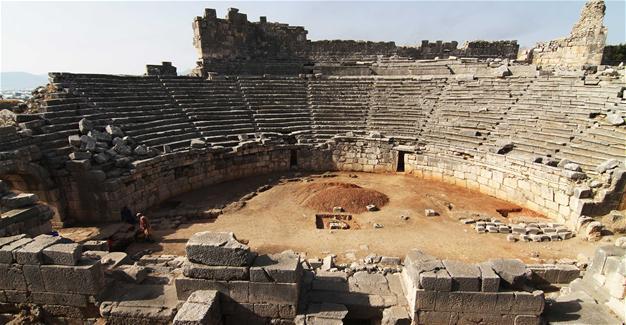‘City of sorrows’ wait for visitors
ANTALYA – Anadolu Agency
 The ancient city of Xanthos in the southern province of Antalya’s Kaş district, known as the “city of sorrows,” opens the door of a different world to its visitors both with its sad history and ruins that defy time.
The ancient city of Xanthos in the southern province of Antalya’s Kaş district, known as the “city of sorrows,” opens the door of a different world to its visitors both with its sad history and ruins that defy time. Excavation work in the ancient city, positioned in Kınık neighborhood, was initiated in 1950 and has been maintained by Akdeniz University Social Sciences Institute Archaeology Department.
The department member and deputy head of the excavations, Aytaç Dönmez, said that the first findings in the ancient city date back to 2,800 years ago and the city entered the UNESCO World Heritage List in 1988.
He said that Xanthos was a leading and powerful city in the Archaic and Classical era, and it was invaded for the first time after the second half of the 6th century.
“Just like they invaded the whole Anatolia, the Persians attacked the Lycian city of Xanthos, too. All men went to war during this attack. When all these men died in the war, the women and children of the city escaped to the acropolis but they understood that the city will be invaded. This is why they burned themselves and jumped from a cliff in the southern part of the acropolis,” Dönmez said, adding that after the war, the city was rebuilt by those who returned.
In the Roman era, Xanthos was wanted to be built as a Roman city in terms of architecture and city planning but the locals of Xanthos objected to it, he said.
“Then Brutus rushed into the city with his armies. All men attacked the Romans in the Agora. Women and children burned themselves on a holy place, known as the Sarpedon road. When he saw all these people who burned themselves, Brutus got sorry and ordered his soldiers to capture each Lycian alive. Then Xanthos became a Roman city,” Dönmez explained.
He said that the city was called the city of sorrows because of these wars and it is home to the Hellenistic, Roman and Byzantine era structures because it was invaded all the time.
“Those living in the city enshrined the architecture and religion of the city and this is why they have never demolished structures. It is possible to see all cultural elements from the archaic era to the Byzantine era together in Xanthos. We can see the elements of only one civilization in some cities. But here we can see a Roman agora as well as tombs from the Archaic and Classical era together. This shows us that Xanthos was a very different city. As a result of our works here, we can get significant information about the Lycian era,” he concluded.
















